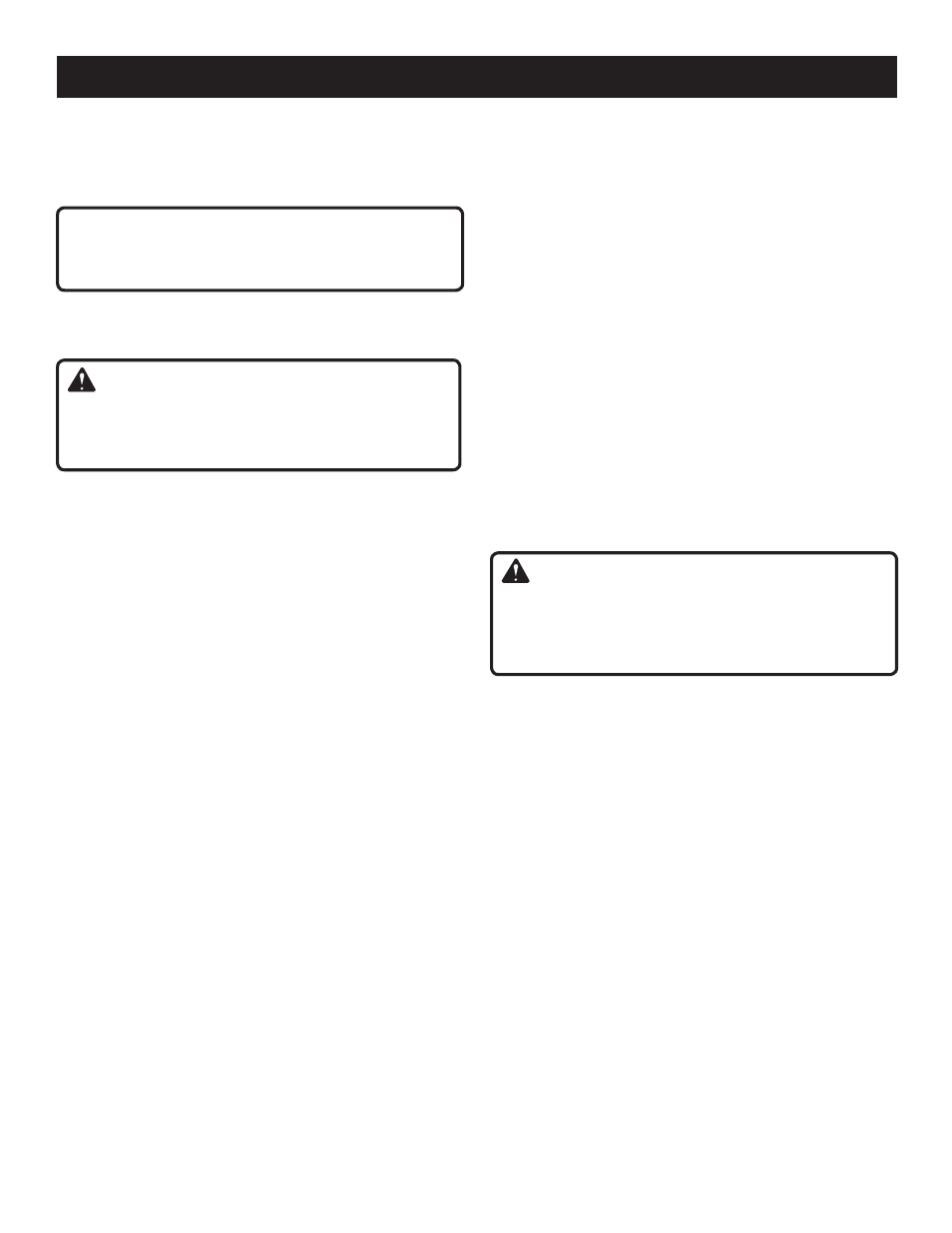Maintenance – Ryobi RY13015 User Manual
Page 15

11 — English
MAINTENANCE
Tighten with a socket wrench and torque to 170 in. lb.
minimum, 190 in. lb. maximum. Do not overtighten.
Secure the engine housing back into place and return the
screw. Ensure that the housing is stable.
NOTICE:
Be careful not to cross thread the spark plug. Cross thread-
ing will seriously damage the product.
CHANGING ENGINE LUBRICANT
See Figure 19.
WARNING:
Do not change engine lubricant while it is hot. Accidental
contact with hot engine lubricant could result in serious
burns.
For best performance, engine lubricant should be changed
after every 25 hours of operation.
Stop the engine and disconnect the spark plug wire. Allow
the engine to cool completely before proceeding.
Remove the oil fill cap/dipstick.
Tip the unit backward so the handles rest on the ground
and allow lubricant to drain from the oil fill hole into an
approved container.
NOTE: Drain the lubricant while the engine is still warm
but not hot. Warm lubricant will drain quickly and more
completely.
Return the unit to an upright position and refill with lubricant
following the instructions in the
Adding/Checking Engine
Lubricant section previously in this manual.
NOTE: Used lubricant should be disposed of at an approved
disposal site. See your local retailer for more information.
ADJUSTING CAMSHAFT-TO-ROCKER ARM
CLEARANCE
See Figures 20 - 22.
Inspect the camshaft-to-rocker arm clearance after every
25 hours of operation. This should be done in a clean, dust-
free environment.
NOTE: This procedure requires partial disassembly of the
engine. If you are unsure if you are qualified to perform this
operation, take the unit to an authorized service center.
Stop the engine and disconnect the spark plug wire. Allow
the engine to cool completely before proceeding.
Remove the screw from the top engine cover. Remove
engine cover and set aside.
Using a Torx screwdriver, remove the screw from the rocker
arm cover. Remove the cover and set aside.
Position camshaft by pulling the recoil starter grip just
until the deep hole in the camshaft gear is located at the
6 o’clock position.
Place the feeler gauge under each rocker arm and measure
the gap. The gap should be between .006 in. (0.15 mm)
and .008 in. (0.20 mm) for both rocker arms.
NOTE: Use a standard automotive feeler gauge. The .006 in.
(0.15 mm) feeler gauge should slide between the rocker
arm and valve stem with a slight amount of resistance but
without binding. The 0.008 in. (0.20 mm) feeler gage should
not slide between the rocker arms and the cam lobes — it
should be held tight.
If the valve clearance is not between .006 in. (0.15 mm)
and .008 in. (0.20 mm), the clearance should be adjusted
as follows:
While holding a wrench on the flats of the adjusting nut
with one hand, loosen the retaining nut with a second
wrench as shown. Take care not to loosen the stud.
Rotate the adjusting nut until it touches the feeler gauge.
Once the gap setting is correct, hold the wrench on the
flats of the adjusting nut and retighten the retaining nut
securely.
Adjust the second rocker arm, if necessary.
Replace the rocker arm cover and screw; tighten securely.
Replace the top engine cover and screw; tighten securely.
WARNING:
Ensure all engine cover and all engine parts are completely
and properly reassembled before starting engine. Failure
to correctly reassemble engine could result in serious injury
or property damage.
STORING THE PRODUCT
Clean all foreign material from the product. Store idle unit
indoors in a dry, well-ventilated area that is inaccessible to
children. Keep away from corrosive agents such as garden
chemicals and de-icing salts.
Abide by all ISO and local regulations for the safe storage
and handling of gasoline.
When storing 1 month or longer:
Drain all fuel from tank into a container approved for gasoline.
Run engine until it stops.
HIGH ALTITUDE ENGINE OPERATION
Please have an authorized service center adjust this engine
if it is to be run above 2000 feet. Failure to do so may result
in poor engine performance and increased emissions. An
engine adjusted for high altitudes can not be run at 2000
feet or lower. In doing so, the engine will overheat and cause
serious engine damage. Please have an authorized service
center restore high altitude modified engines to the original
factory specification before operating below 2000 feet.
